The Cambridge History of Japan, Vol. 1: Ancient Japan
Подождите немного. Документ загружается.

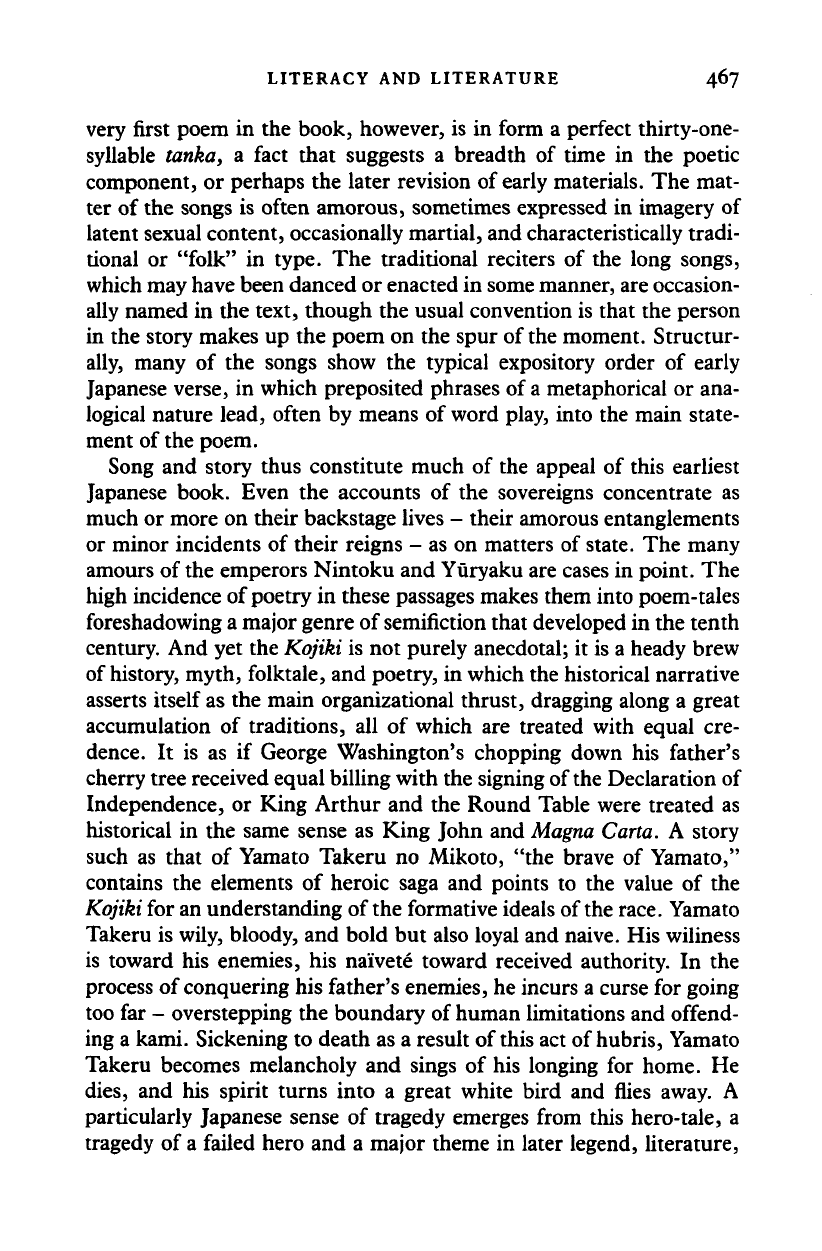
LITERACY AND LITERATURE 467
very first poem in the book, however, is in form a perfect thirty-one-
syllable tonka, a fact that suggests a breadth of time in the poetic
component, or perhaps the later revision of early materials. The mat-
ter of the songs is often amorous, sometimes expressed in imagery of
latent sexual content, occasionally martial, and characteristically tradi-
tional or "folk" in type. The traditional reciters of the long songs,
which may have been danced or enacted in some manner, are occasion-
ally named in the text, though the usual convention is that the person
in the story makes up the poem on the spur of the moment. Structur-
ally, many of the songs show the typical expository order of early
Japanese verse, in which preposited phrases of
a
metaphorical or ana-
logical nature lead, often by means of word play, into the main state-
ment of the poem.
Song and story thus constitute much of the appeal of this earliest
Japanese book. Even the accounts of the sovereigns concentrate as
much or more on their backstage lives - their amorous entanglements
or minor incidents of their reigns - as on matters of
state.
The many
amours of the emperors Nintoku and Yuryaku are cases in point. The
high incidence of poetry in these passages makes them into poem-tales
foreshadowing a major genre of semifiction that developed in the tenth
century. And yet the Kojiki is not purely anecdotal; it is a heady brew
of history, myth, folktale, and poetry, in which the historical narrative
asserts itself as the main organizational thrust, dragging along a great
accumulation of traditions, all of which are treated with equal cre-
dence. It is as if George Washington's chopping down his father's
cherry tree received equal billing with the signing of the Declaration of
Independence, or King Arthur and the Round Table were treated as
historical in the same sense as King John and
Magna
Carta.
A story
such as that of Yamato Takeru no Mikoto, "the brave of Yamato,"
contains the elements of heroic saga and points to the value of the
Kojiki for an understanding of the formative ideals of the race. Yamato
Takeru is wily, bloody, and bold but also loyal and naive. His wiliness
is toward his enemies, his naivete toward received authority. In the
process of conquering his father's enemies, he incurs a curse for going
too far - overstepping the boundary of human limitations and offend-
ing a kami. Sickening to death as a result of
this
act of
hubris,
Yamato
Takeru becomes melancholy and sings of his longing for home. He
dies,
and his spirit turns into a great white bird and flies away. A
particularly Japanese sense of tragedy emerges from this hero-tale, a
tragedy of a failed hero and a major theme in later legend, literature,
Cambridge Histories Online © Cambridge University Press, 2008
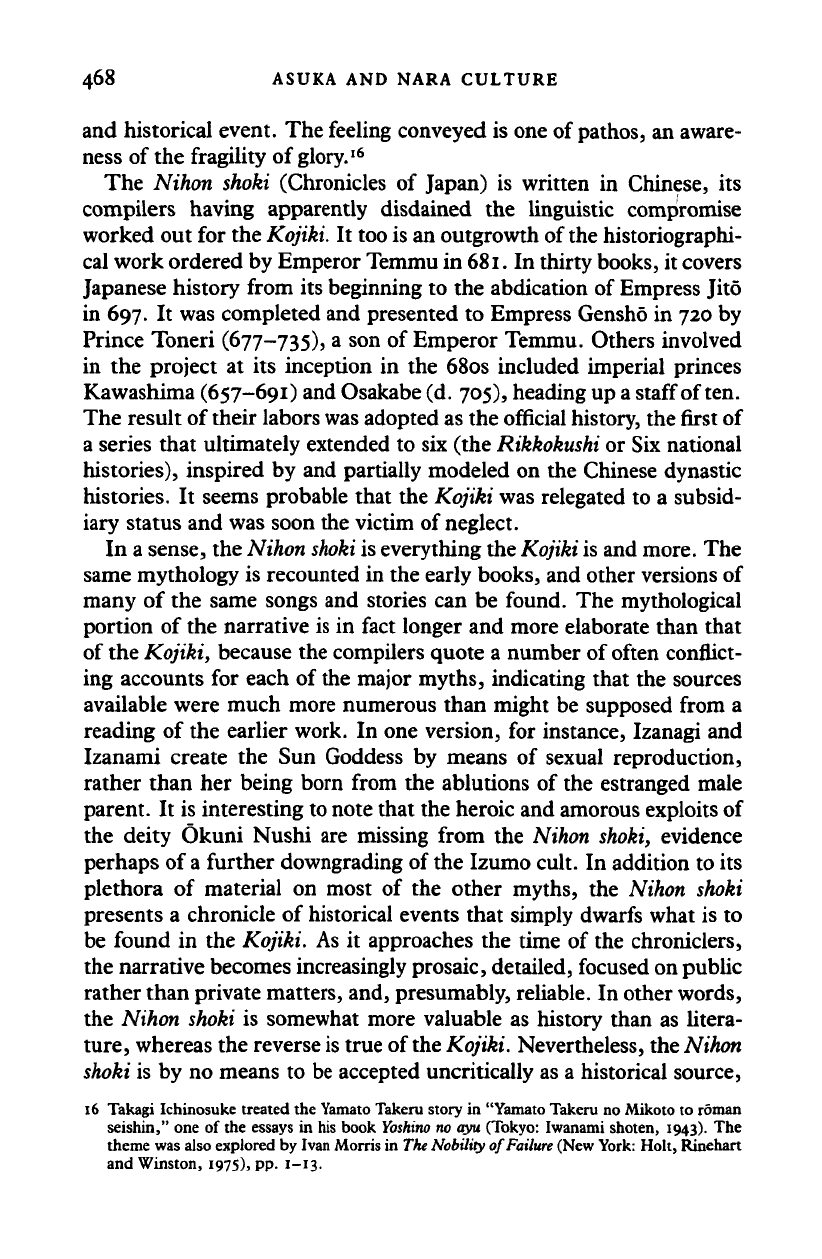
468 ASUKA AND NARA CULTURE
and historical event. The feeling conveyed is one of
pathos,
an aware-
ness of the fragility of glory.
16
The Nihon shoki (Chronicles of Japan) is written in Chinese, its
compilers having apparently disdained the linguistic compromise
worked out for the
Kojiki.
It too is an outgrowth of the historiographi-
cal work ordered by Emperor Temmu in
681.
In thirty books, it covers
Japanese history from its beginning to the abdication of Empress Jito
in 697. It was completed and presented to Empress Gensho in 720 by
Prince Toneri (677-735), a son of Emperor Temmu. Others involved
in the project at its inception in the 680s included imperial princes
Kawashima (657-691) and Osakabe (d. 705), heading up a staff of ten.
The result of their labors was adopted as the official history, the first of
a series that ultimately extended to six (the Rikkokushi or Six national
histories), inspired by and partially modeled on the Chinese dynastic
histories. It seems probable that the Kojiki was relegated to a subsid-
iary status and was soon the victim of neglect.
In a sense, the Nihon
shoki
is everything the Kojiki
is
and more. The
same mythology is recounted in the early books, and other versions of
many of the same songs and stories can be found. The mythological
portion of the narrative is in fact longer and more elaborate than that
of the Kojiki, because the compilers quote a number of often conflict-
ing accounts for each of the major myths, indicating that the sources
available were much more numerous than might be supposed from a
reading of the earlier work. In one version, for instance, Izanagi and
Izanami create the Sun Goddess by means of sexual reproduction,
rather than her being born from the ablutions of the estranged male
parent. It is interesting to note that the heroic and amorous exploits of
the deity Okuni Nushi are missing from the Nihon shoki, evidence
perhaps of
a
further downgrading of the Izumo cult. In addition to its
plethora of material on most of the other myths, the Nihon shoki
presents a chronicle of historical events that simply dwarfs what is to
be found in the Kojiki. As it approaches the time of the chroniclers,
the narrative becomes increasingly prosaic, detailed, focused on public
rather than private matters, and, presumably, reliable. In other words,
the Nihon shoki is somewhat more valuable as history than as litera-
ture,
whereas the reverse
is
true of
the
Kojiki. Nevertheless, the Nihon
shoki
is by no means to be accepted uncritically as a historical source,
16 Takagi Ichinosuke treated the Yamato Takeru story in "Yamato Takeru no Mikoto to roman
seishin," one of the essays in his book
Yoshino no
ayu (Tokyo: Iwanami shoten, 1943). The
theme was also explored by Ivan Morris in
The Nobility
of
Failure
(New York: Holt, Rinehart
and Winston, 1975), pp. 1-13.
Cambridge Histories Online © Cambridge University Press, 2008
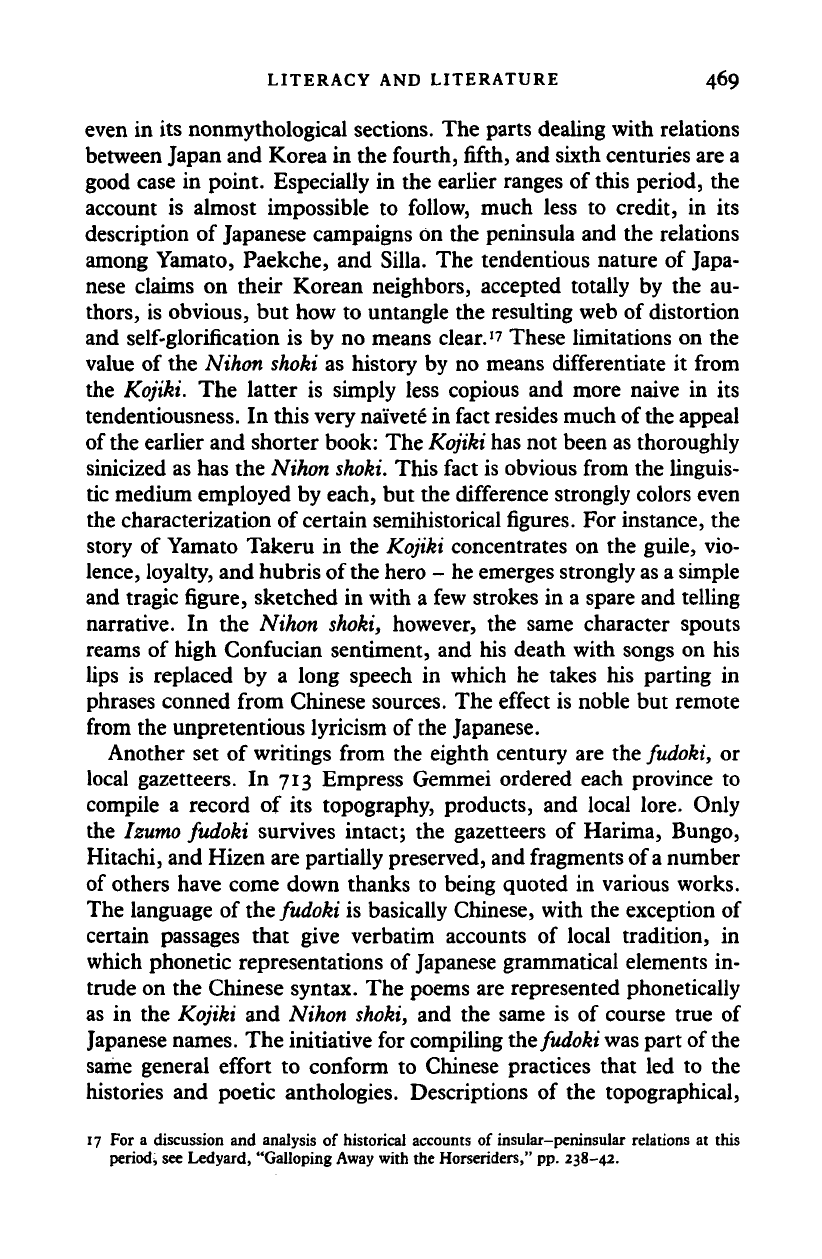
LITERACY AND LITERATURE 469
even in its nonmythological sections. The parts dealing with relations
between Japan and Korea in the fourth, fifth, and sixth centuries are a
good case in point. Especially in the earlier ranges of this period, the
account is almost impossible to follow, much less to credit, in its
description of Japanese campaigns on the peninsula and the relations
among Yamato, Paekche, and Silla. The tendentious nature of Japa-
nese claims on their Korean neighbors, accepted totally by the au-
thors,
is obvious, but how to untangle the resulting web of distortion
and self-glorification is by no means clear.
17
These limitations on the
value of the Nihon shoki as history by no means differentiate it from
the Kojiki. The latter is simply less copious and more naive in its
tendentiousness. In this very naivete in fact resides much of
the
appeal
of the earlier and shorter book: The Kojiki has not been as thoroughly
sinicized as has the Nihon
shoki.
This fact is obvious from the linguis-
tic medium employed by each, but the difference strongly colors even
the characterization of certain semihistorical figures. For instance, the
story of Yamato Takeru in the Kojiki concentrates on the guile, vio-
lence, loyalty, and hubris of the hero - he emerges strongly as a simple
and tragic figure, sketched in with a few strokes in a spare and telling
narrative. In the Nihon shoki, however, the same character spouts
reams of high Confucian sentiment, and his death with songs on his
lips is replaced by a long speech in which he takes his parting in
phrases conned from Chinese sources. The effect is noble but remote
from the unpretentious lyricism of the Japanese.
Another set of writings from the eighth century are the fudoki, or
local gazetteers. In 713 Empress Gemmei ordered each province to
compile a record of its topography, products, and local lore. Only
the Izumo fudoki survives intact; the gazetteers of Harima, Bungo,
Hitachi, and Hizen are partially preserved, and fragments of a number
of others have come down thanks to being quoted in various works.
The language of the fudoki is basically Chinese, with the exception of
certain passages that give verbatim accounts of local tradition, in
which phonetic representations of Japanese grammatical elements in-
trude on the Chinese syntax. The poems are represented phonetically
as in the Kojiki and Nihon shoki, and the same is of course true of
Japanese names. The initiative for compiling the fudoki was part of the
same general effort to conform to Chinese practices that led to the
histories and poetic anthologies. Descriptions of the topographical,
17 For a discussion and analysis of historical accounts of insular-peninsular relations at this
period, see Ledyard, "Galloping Away with the Horseriders," pp. 238-42.
Cambridge Histories Online © Cambridge University Press, 2008
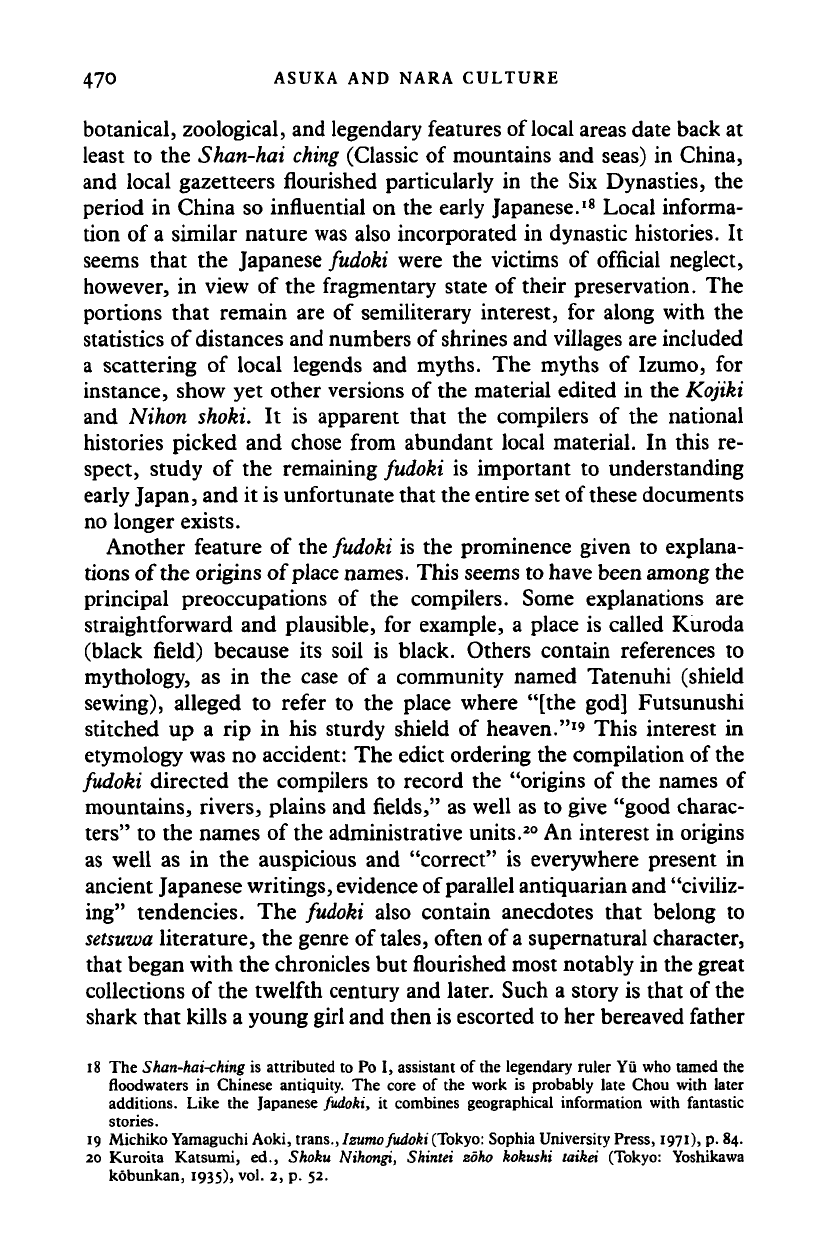
470 ASUKA AND NARA CULTURE
botanical, zoological, and legendary features of local areas date back at
least to the Shan-hai
ching
(Classic of mountains and seas) in China,
and local gazetteers flourished particularly in the Six Dynasties, the
period in China so influential on the early Japanese.
18
Local informa-
tion of a similar nature was also incorporated in dynastic histories. It
seems that the Japanese fudoki were the victims of official neglect,
however, in view of the fragmentary state of their preservation. The
portions that remain are of semiliterary interest, for along with the
statistics of distances and numbers of shrines and villages are included
a scattering of local legends and myths. The myths of Izumo, for
instance, show yet other versions of the material edited in the Kojiki
and Nihon shoki. It is apparent that the compilers of the national
histories picked and chose from abundant local material. In this re-
spect, study of the remaining fudoki is important to understanding
early Japan, and it is unfortunate that the entire set of these documents
no longer exists.
Another feature of the fudoki is the prominence given to explana-
tions of the origins of place
names.
This seems to have been among the
principal preoccupations of the compilers. Some explanations are
straightforward and plausible, for example, a place is called Kuroda
(black field) because its soil is black. Others contain references to
mythology, as in the case of a community named Tatenuhi (shield
sewing), alleged to refer to the place where "[the god] Futsunushi
stitched up a rip in his sturdy shield of heaven."
19
This interest in
etymology was no accident: The edict ordering the compilation of the
fudoki directed the compilers to record the "origins of the names of
mountains, rivers, plains and fields," as well as to give "good charac-
ters"
to the names of the administrative units.
20
An interest in origins
as well as in the auspicious and "correct" is everywhere present in
ancient Japanese writings, evidence of parallel antiquarian and "civiliz-
ing" tendencies. The fudoki also contain anecdotes that belong to
setsuwa
literature, the genre of
tales,
often of
a
supernatural character,
that began with the chronicles but flourished most notably in the great
collections of the twelfth century and later. Such a story is that of the
shark that kills a young girl and then is escorted to her bereaved father
18 The Shan-hai-ching is attributed to Po I, assistant of the legendary ruler Yu who tamed the
floodwaters in Chinese antiquity. The core of the work is probably late Chou with later
additions. Like the Japanese fudoki, it combines geographical information with fantastic
stories.
19 Michiko Yamaguchi Aoki, trans., Izumo fudoki
(Tokyo:
Sophia University Press, 1971), p. 84.
20 Kuroita Katsumi, ed., Shoku Nihongi, Shintei zoho kokushi taikei (Tokyo: Yoshikawa
kobunkan, 1935), vol. 2, p. 52.
Cambridge Histories Online © Cambridge University Press, 2008
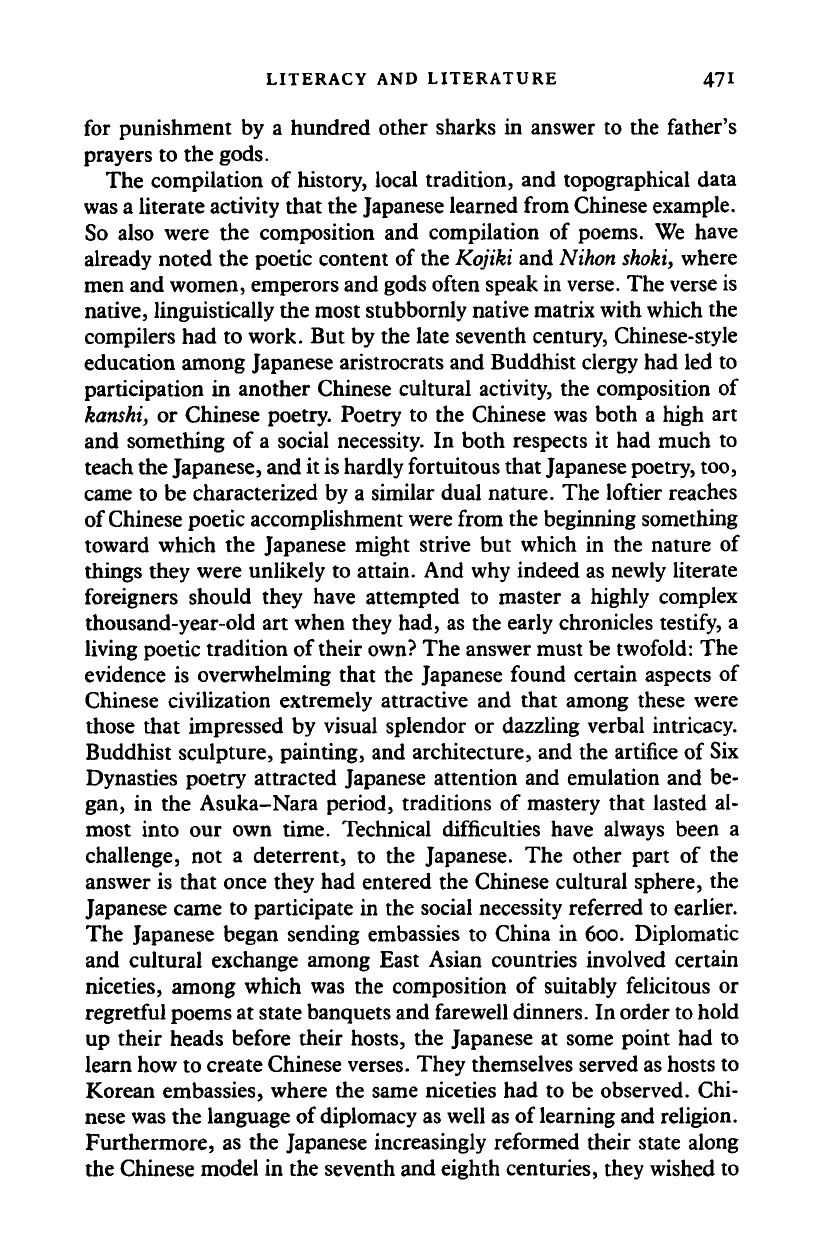
LITERACY AND LITERATURE 471
for punishment by a hundred other sharks in answer to the father's
prayers to the gods.
The compilation of history, local tradition, and topographical data
was a literate activity that the Japanese learned from Chinese example.
So also were the composition and compilation of poems. We have
already noted the poetic content of the Kojiki and Nihon
shoki,
where
men and women, emperors and gods often speak in verse. The verse is
native, linguistically the most stubbornly native matrix with which the
compilers had to work. But by the late seventh century, Chinese-style
education among Japanese aristrocrats and Buddhist clergy had led to
participation in another Chinese cultural activity, the composition of
kanshi, or Chinese poetry. Poetry to the Chinese was both a high art
and something of a social necessity. In both respects it had much to
teach the Japanese, and it
is
hardly fortuitous that Japanese poetry, too,
came to be characterized by a similar dual nature. The loftier reaches
of Chinese poetic accomplishment were from the beginning something
toward which the Japanese might strive but which in the nature of
things they were unlikely to attain. And why indeed as newly literate
foreigners should they have attempted to master a highly complex
thousand-year-old art when they had, as the early chronicles testify, a
living poetic tradition of their own? The answer must be twofold: The
evidence is overwhelming that the Japanese found certain aspects of
Chinese civilization extremely attractive and that among these were
those that impressed by visual splendor or dazzling verbal intricacy.
Buddhist sculpture, painting, and architecture, and the artifice of Six
Dynasties poetry attracted Japanese attention and emulation and be-
gan, in the Asuka-Nara period, traditions of mastery that lasted al-
most into our own time. Technical difficulties have always been a
challenge, not a deterrent, to the Japanese. The other part of the
answer is that once they had entered the Chinese cultural sphere, the
Japanese came to participate in the social necessity referred to earlier.
The Japanese began sending embassies to China in 600. Diplomatic
and cultural exchange among East Asian countries involved certain
niceties, among which was the composition of suitably felicitous or
regretful poems at state banquets and farewell dinners. In order to hold
up their heads before their hosts, the Japanese at some point had to
learn how to create Chinese verses. They themselves served as hosts to
Korean embassies, where the same niceties had to be observed. Chi-
nese was the language of diplomacy as well as of learning and religion.
Furthermore, as the Japanese increasingly reformed their state along
the Chinese model in the seventh and eighth centuries, they wished to
Cambridge Histories Online © Cambridge University Press, 2008
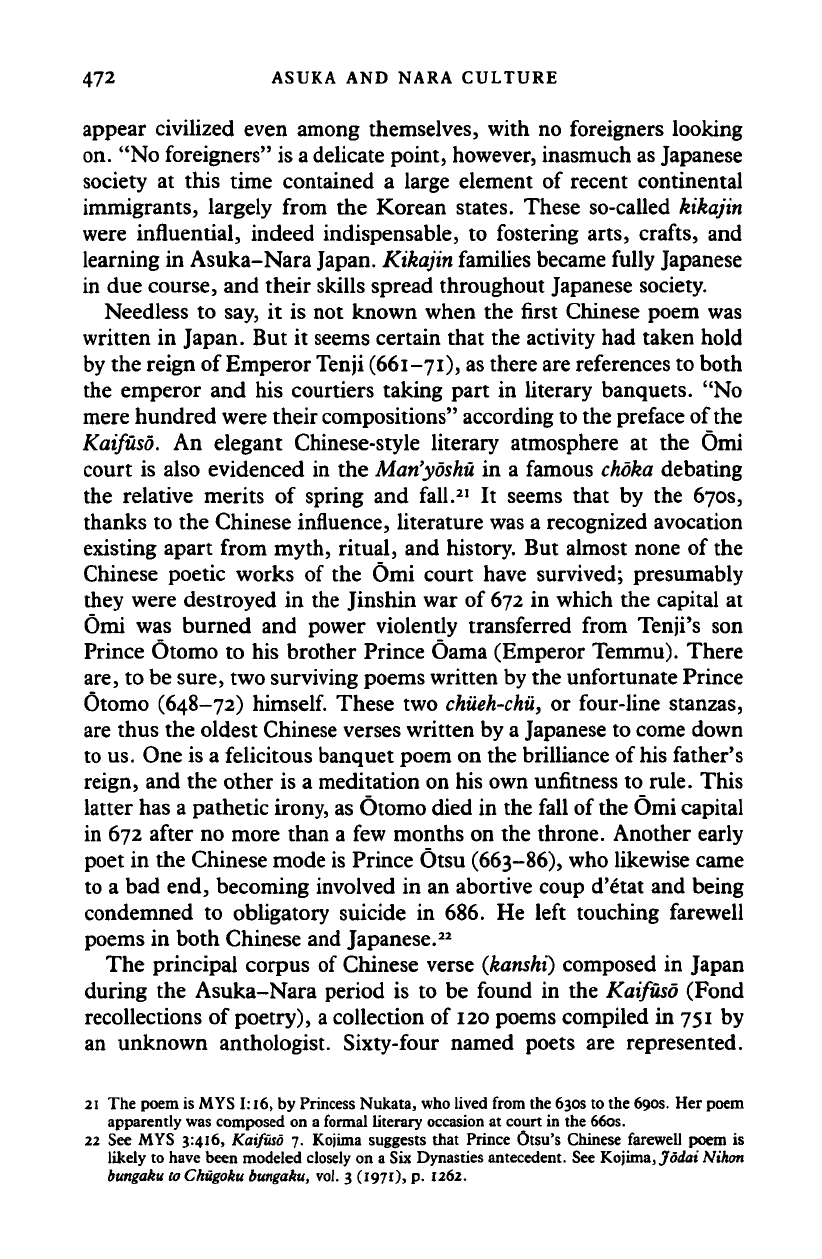
472 ASUKA AND NARA CULTURE
appear civilized even among themselves, with no foreigners looking
on. "No foreigners" is a delicate point, however, inasmuch as Japanese
society at this time contained a large element of recent continental
immigrants, largely from the Korean states. These so-called kikajin
were influential, indeed indispensable, to fostering arts, crafts, and
learning in Asuka-Nara Japan. Kikajin families became fully Japanese
in due course, and their skills spread throughout Japanese society.
Needless to say, it is not known when the first Chinese poem was
written in Japan. But it seems certain that the activity had taken hold
by the reign of Emperor Tenji (661-71), as there are references to both
the emperor and his courtiers taking part in literary banquets. "No
mere hundred were their compositions" according to the preface of the
Kaifuso. An elegant Chinese-style literary atmosphere at the Omi
court is also evidenced in the
Man'yoshu
in a famous
choka
debating
the relative merits of spring and fall.
21
It seems that by the 670s,
thanks to the Chinese influence, literature was a recognized avocation
existing apart from myth, ritual, and history. But almost none of the
Chinese poetic works of the Omi court have survived; presumably
they were destroyed in the Jinshin war of
672
in which the capital at
Omi was burned and power violently transferred from Tenji's son
Prince Otomo to his brother Prince Oama (Emperor Temmu). There
are,
to be sure, two surviving poems written by the unfortunate Prince
Otomo (648-72)
himself.
These two
chueh-chu,
or four-line stanzas,
are thus the oldest Chinese verses written by a Japanese to come down
to us. One is a felicitous banquet poem on the brilliance of
his
father's
reign, and the other is a meditation on his own unfitness to rule. This
latter has a pathetic irony, as Otomo died in the fall of the Omi capital
in 672 after no more than a few months on the throne. Another early
poet in the Chinese mode is Prince Otsu (663-86), who likewise came
to a bad end, becoming involved in an abortive coup d'etat and being
condemned to obligatory suicide in 686. He left touching farewell
poems in both Chinese and Japanese.
22
The principal corpus of Chinese verse
(kanshi)
composed in Japan
during the Asuka-Nara period is to be found in the Kaifuso (Fond
recollections of poetry), a collection of 120 poems compiled in
751
by
an unknown anthologist. Sixty-four named poets are represented.
21
The
poem
is
MYS
I:
i6,
by
Princess
Nukata,
who lived from
the
630s
to the
690s.
Her
poem
apparently was composed
on a
formal literary occasion
at
court
in the
660s.
22
See MYS
3:416,
Kaifuso
7.
Kojima suggests that Prince Otsu's Chinese farewell poem
is
likely
to
have been modeled closely
on a Six
Dynasties
antecedent.
See
Kojima,
Jodai Nihon
bungaku to Chugoku
bungaku,
vol.
3
(1971),
p. 1262.
Cambridge Histories Online © Cambridge University Press, 2008
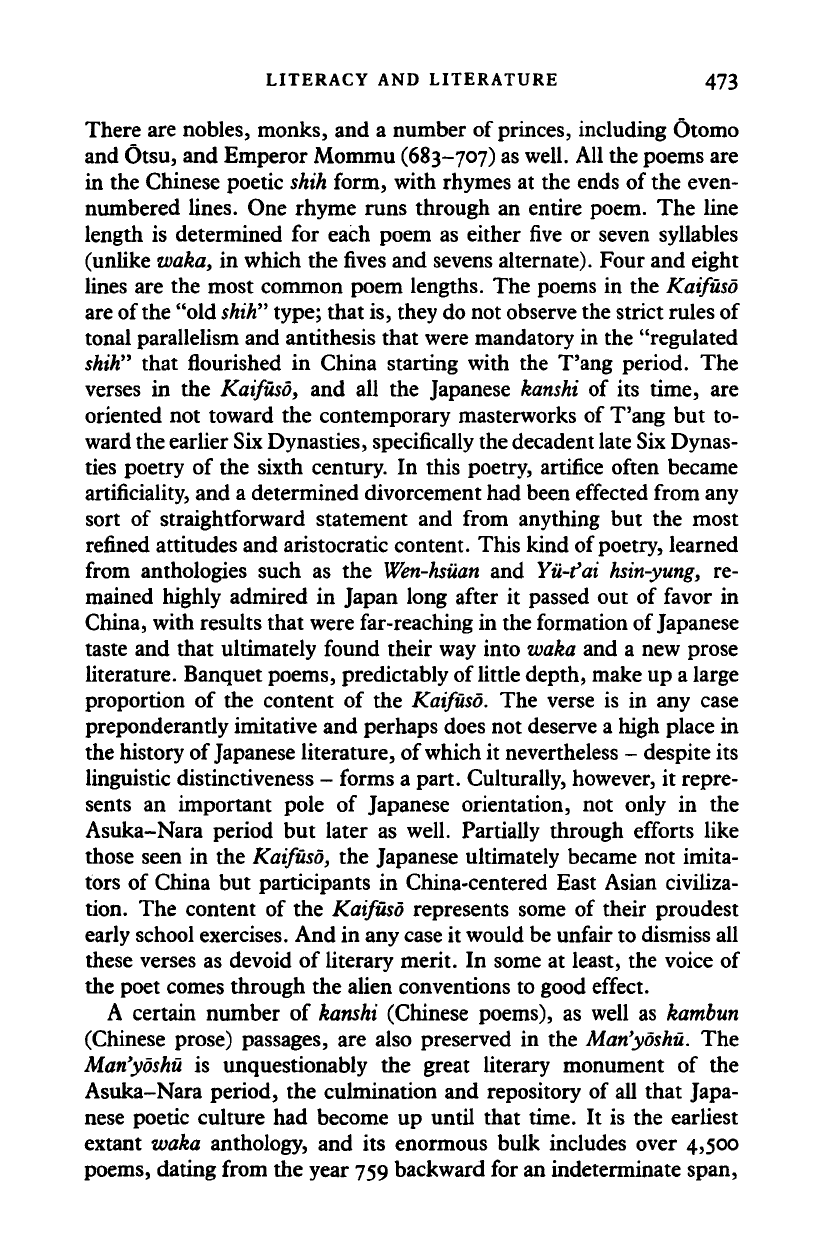
LITERACY AND LITERATURE 473
There are nobles, monks, and a number of
princes,
including Otomo
and Otsu, and Emperor Mommu (683-707) as well. All the poems are
in the Chinese poetic
shih
form, with rhymes at the ends of the even-
numbered lines. One rhyme runs through an entire poem. The line
length is determined for each poem as either five or seven syllables
(unlike waka, in which the fives and sevens alternate). Four and eight
lines are the most common poem lengths. The poems in the Kaifuso
are of the "old
shih"
type; that
is,
they do not observe the strict rules of
tonal parallelism and antithesis that were mandatory in the "regulated
shih"
that flourished in China starting with the T'ang period. The
verses in the Kaifuso, and all the Japanese kanshi of its time, are
oriented not toward the contemporary masterworks of T'ang but to-
ward the earlier Six Dynasties, specifically the decadent late Six Dynas-
ties poetry of the sixth century. In this poetry, artifice often became
artificiality, and a determined divorcement had been effected from any
sort of straightforward statement and from anything but the most
refined attitudes and aristocratic content. This kind of poetry, learned
from anthologies such as the
Wen-hsiian
and Yu-tai
hsin-yung,
re-
mained highly admired in Japan long after it passed out of favor in
China, with results that were far-reaching in the formation of Japanese
taste and that ultimately found their way into waka and a new prose
literature. Banquet poems, predictably of little depth, make up a large
proportion of the content of the Kaifuso. The verse is in any case
preponderantly imitative and perhaps does not deserve a high place in
the history of Japanese literature, of which it nevertheless - despite its
linguistic distinctiveness - forms a part. Culturally, however, it repre-
sents an important pole of Japanese orientation, not only in the
Asuka-Nara period but later as well. Partially through efforts like
those seen in the Kaifuso, the Japanese ultimately became not imita-
tors of China but participants in China-centered East Asian civiliza-
tion. The content of the Kaifuso represents some of their proudest
early school exercises. And in any case it would be unfair to dismiss all
these verses as devoid of literary merit. In some at least, the voice of
the poet comes through the alien conventions to good effect.
A certain number of kanshi (Chinese poems), as well as kambun
(Chinese prose) passages, are also preserved in the
Man'yoshu.
The
Man'yoshu is unquestionably the great literary monument of the
Asuka-Nara period, the culmination and repository of all that Japa-
nese poetic culture had become up until that time. It is the earliest
extant waka anthology, and its enormous bulk includes over 4,500
poems, dating from the year 759 backward for an indeterminate span,
Cambridge Histories Online © Cambridge University Press, 2008
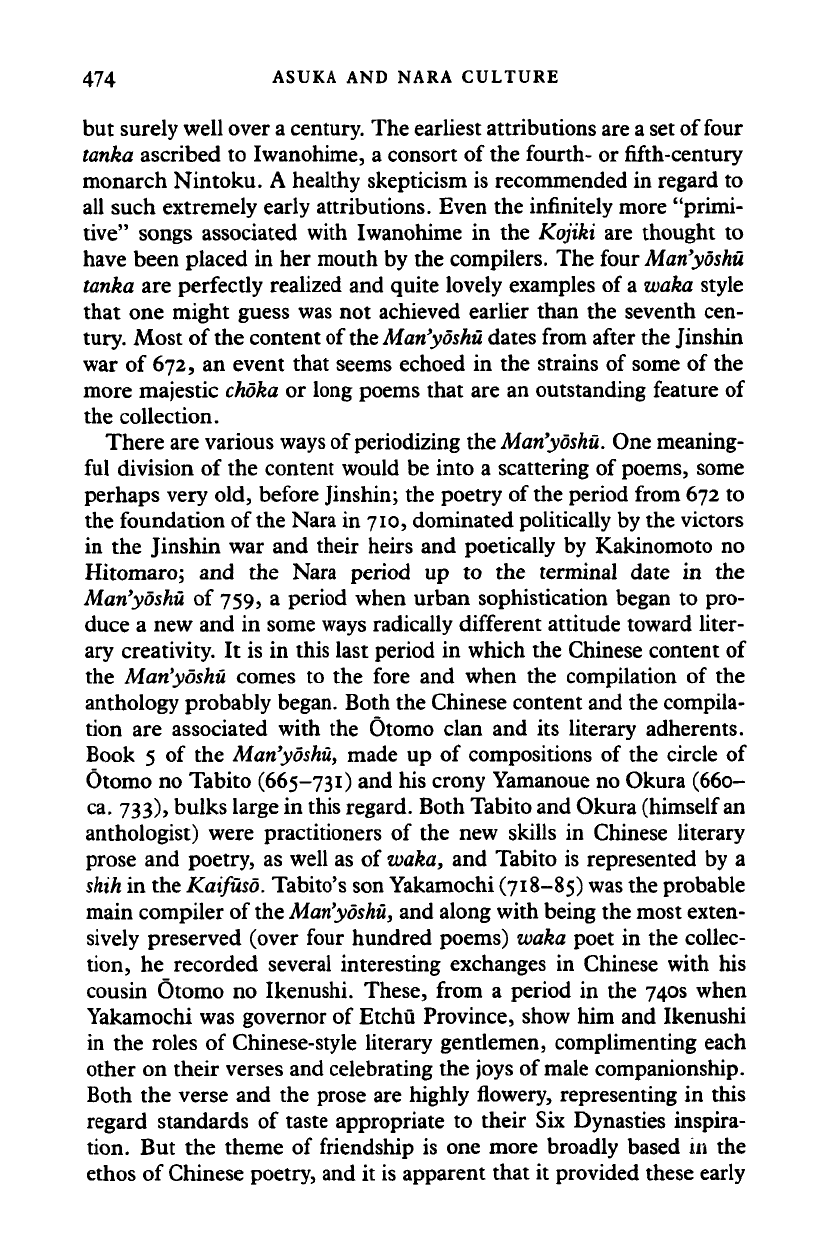
474 ASUKA AND NARA CULTURE
but surely well over a century. The earliest attributions are a set of four
tonka ascribed to Iwanohime, a consort of the fourth- or fifth-century
monarch Nintoku. A healthy skepticism is recommended in regard to
all such extremely early attributions. Even the infinitely more "primi-
tive"
songs associated with Iwanohime in the Kojiki are thought to
have been placed in her mouth by the compilers. The four
Man'yoshu
tanka are perfectly realized and quite lovely examples of a waka style
that one might guess was not achieved earlier than the seventh cen-
tury. Most of the content of the
Man'yoshu
dates from after the Jinshin
war of 672, an event that seems echoed in the strains of some of the
more majestic
choka
or long poems that are an outstanding feature of
the collection.
There are various ways of periodizing the
Man'yoshu.
One meaning-
ful division of the content would be into a scattering of poems, some
perhaps very old, before Jinshin; the poetry of the period from 672 to
the foundation of the Nara in 710, dominated politically by the victors
in the Jinshin war and their heirs and poetically by Kakinomoto no
Hitomaro; and the Nara period up to the terminal date in the
Man'yoshu of 759, a period when urban sophistication began to pro-
duce a new and in some ways radically different attitude toward liter-
ary creativity. It is in this last period in which the Chinese content of
the Man'yoshu comes to the fore and when the compilation of the
anthology probably began. Both the Chinese content and the compila-
tion are associated with the Otomo clan and its literary adherents.
Book 5 of the
Man'yoshu,
made up of compositions of the circle of
Otomo no Tabito (665-731) and his crony Yamanoue no Okura (660-
ca. 733), bulks large in this regard. Both Tabito and Okura (himself an
anthologist) were practitioners of the new skills in Chinese literary
prose and poetry, as well as of waka, and Tabito is represented by a
shih
in the Kaifuso. Tabito's son Yakamochi (718-85) was the probable
main compiler of the
Man'yoshu,
and along with being the most exten-
sively preserved (over four hundred poems) waka poet in the collec-
tion, he recorded several interesting exchanges in Chinese with his
cousin Otomo no Ikenushi. These, from a period in the 740s when
Yakamochi was governor of Etchu Province, show him and Ikenushi
in the roles of Chinese-style literary gentlemen, complimenting each
other on their verses and celebrating the joys of
male
companionship.
Both the verse and the prose are highly flowery, representing in this
regard standards of taste appropriate to their Six Dynasties inspira-
tion. But the theme of friendship is one more broadly based
111
the
ethos of Chinese poetry, and it is apparent that it provided these early
Cambridge Histories Online © Cambridge University Press, 2008
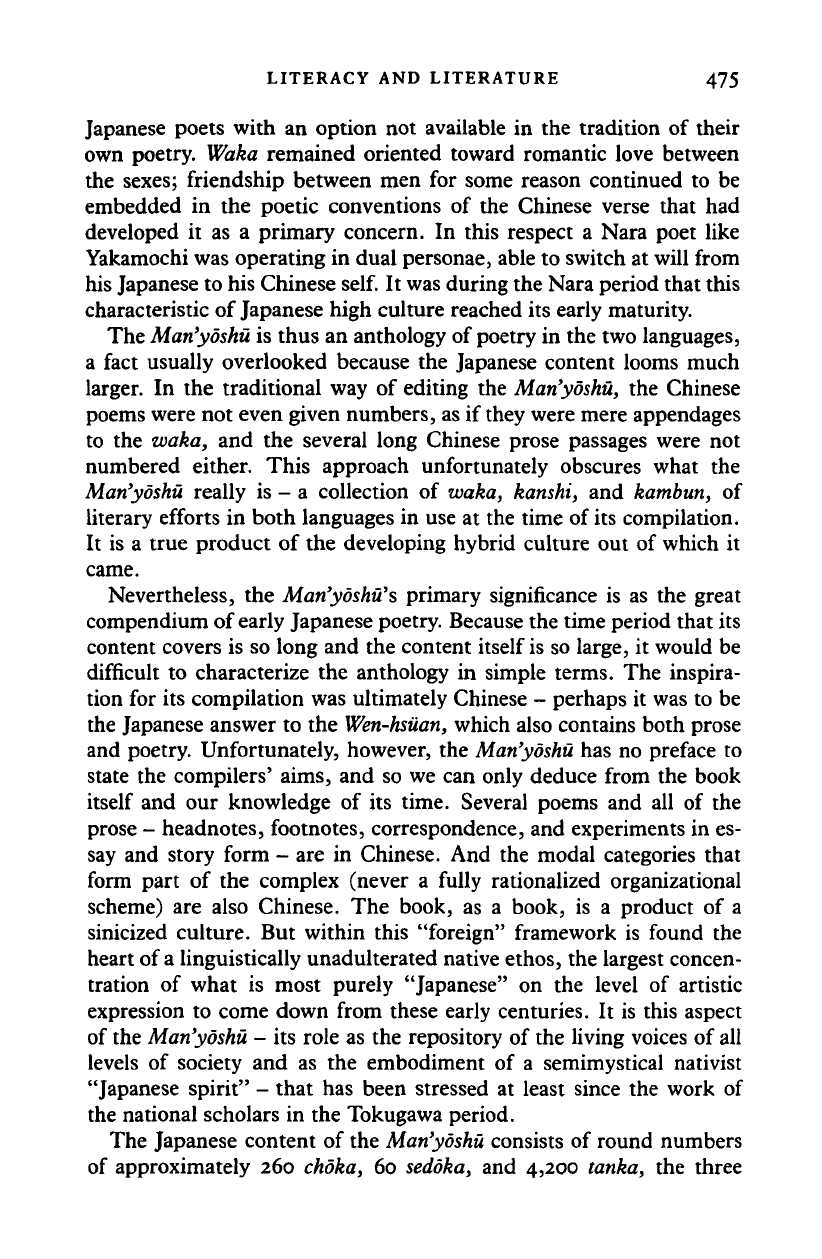
LITERACY AND LITERATURE 475
Japanese poets with an option not available in the tradition of their
own poetry. Waka remained oriented toward romantic love between
the sexes; friendship between men for some reason continued to be
embedded in the poetic conventions of the Chinese verse that had
developed it as a primary concern. In this respect a Nara poet like
Yakamochi was operating in dual personae, able to switch at will from
his Japanese to his Chinese
self.
It was during the Nara period that this
characteristic of Japanese high culture reached its early maturity.
The
Man'yoshu
is thus an anthology of poetry in the two languages,
a fact usually overlooked because the Japanese content looms much
larger. In the traditional way of editing the
Man'yoshu,
the Chinese
poems were not even given numbers, as if they were mere appendages
to the waka, and the several long Chinese prose passages were not
numbered either. This approach unfortunately obscures what the
Man'yoshu really is - a collection of waka, kanshi, and kambun, of
literary efforts in both languages in use at the time of its compilation.
It is a true product of the developing hybrid culture out of which it
came.
Nevertheless, the Man'yoshu's primary significance is as the great
compendium of early Japanese poetry. Because the time period that its
content covers is so long and the content itself is so large, it would be
difficult to characterize the anthology in simple terms. The inspira-
tion for its compilation was ultimately Chinese - perhaps it was to be
the Japanese answer to the
Wen-hsiian,
which also contains both prose
and poetry. Unfortunately, however, the
Man'yoshu
has no preface to
state the compilers' aims, and so we can only deduce from the book
itself and our knowledge of its time. Several poems and all of the
prose - headnotes, footnotes, correspondence, and experiments in es-
say and story form - are in Chinese. And the modal categories that
form part of the complex (never a fully rationalized organizational
scheme) are also Chinese. The book, as a book, is a product of a
sinicized culture. But within this "foreign" framework is found the
heart of
a
linguistically unadulterated native ethos, the largest concen-
tration of what is most purely "Japanese" on the level of artistic
expression to come down from these early centuries. It is this aspect
of the
Man'yoshu
- its role as the repository of the living voices of all
levels of society and as the embodiment of a semimystical nativist
"Japanese spirit" - that has been stressed at least since the work of
the national scholars in the Tokugawa period.
The Japanese content of the
Man'yoshu
consists of round numbers
of approximately 260 choka, 60
sedoka,
and 4,200 tanka, the three
Cambridge Histories Online © Cambridge University Press, 2008
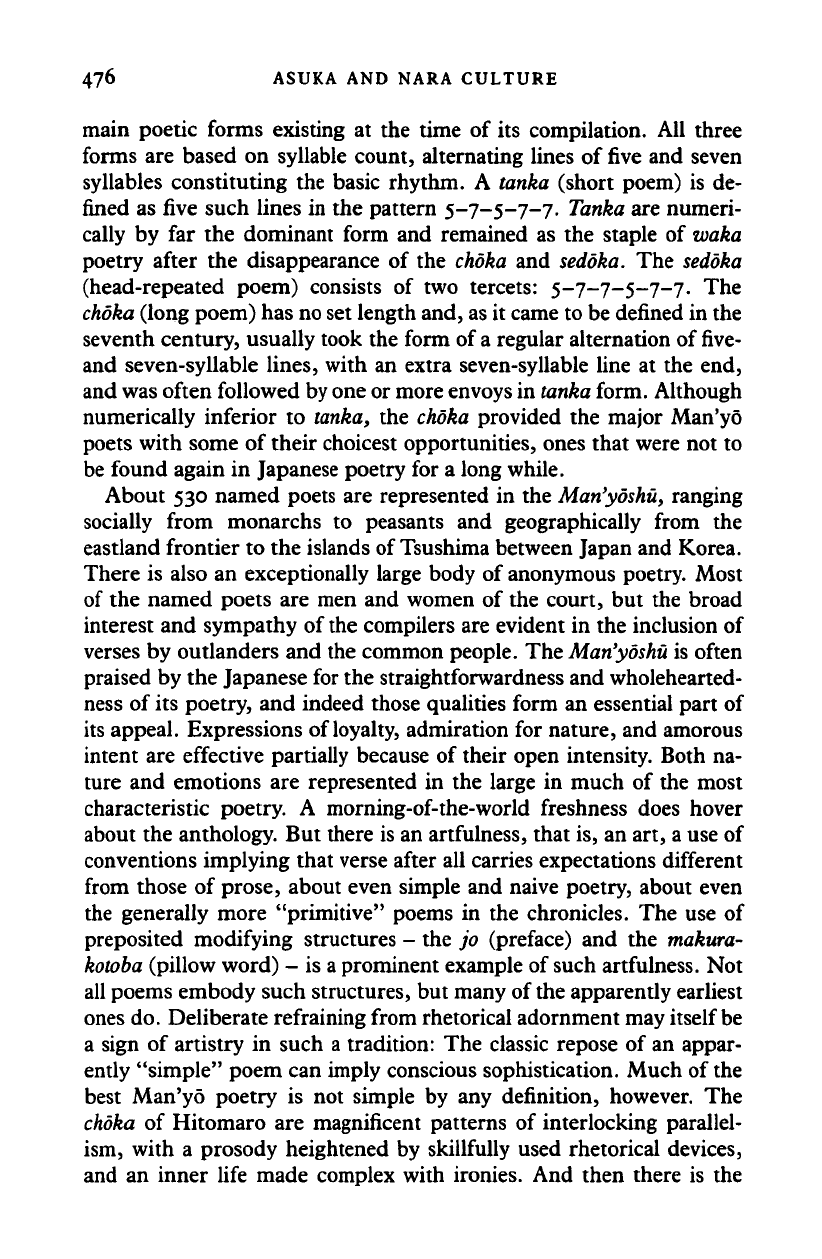
476 ASUKA AND NARA CULTURE
main poetic forms existing at the time of its compilation. All three
forms are based on syllable count, alternating lines of five and seven
syllables constituting the basic rhythm. A tanka (short poem) is de-
fined as five such lines in the pattern 5-7-5-7-7.
Tanka
are numeri-
cally by far the dominant form and remained as the staple of waka
poetry after the disappearance of the choka and
sedoka.
The
sedoka
(head-repeated poem) consists of two tercets: 5-7-7-5-7-7. The
choka
(long poem) has no set length and, as it came to be defined in the
seventh century, usually took the form of
a
regular alternation of five-
and seven-syllable lines, with an extra seven-syllable line at the end,
and was often followed
by
one or more envoys in
tanka
form. Although
numerically inferior to tanka, the
choka
provided the major Man'yo
poets with some of their choicest opportunities, ones that were not to
be found again in Japanese poetry for a long while.
About 530 named poets are represented in the
Man'yoshu,
ranging
socially from monarchs to peasants and geographically from the
eastland frontier to the islands of Tsushima between Japan and Korea.
There is also an exceptionally large body of anonymous poetry. Most
of the named poets are men and women of the court, but the broad
interest and sympathy of
the
compilers are evident in the inclusion of
verses by outlanders and the common people. The
Man'yoshu
is often
praised by the Japanese for the straightforwardness and wholehearted-
ness of its poetry, and indeed those qualities form an essential part of
its appeal. Expressions of loyalty, admiration for nature, and amorous
intent are effective partially because of their open intensity. Both na-
ture and emotions are represented in the large in much of the most
characteristic poetry. A morning-of-the-world freshness does hover
about the anthology. But there is an artfulness, that is, an art, a use of
conventions implying that verse after all carries expectations different
from those of prose, about even simple and naive poetry, about even
the generally more "primitive" poems in the chronicles. The use of
preposited modifying structures - the jo (preface) and the makura-
kotoba
(pillow word) - is a prominent example of such artfulness. Not
all poems embody such structures, but many of the apparently earliest
ones do. Deliberate refraining from rhetorical adornment may itself
be
a sign of artistry in such a tradition: The classic repose of an appar-
ently "simple" poem can imply conscious sophistication. Much of the
best Man'yo poetry is not simple by any definition, however. The
choka of Hitomaro are magnificent patterns of interlocking parallel-
ism, with a prosody heightened by skillfully used rhetorical devices,
and an inner life made complex with ironies. And then there is the
Cambridge Histories Online © Cambridge University Press, 2008
